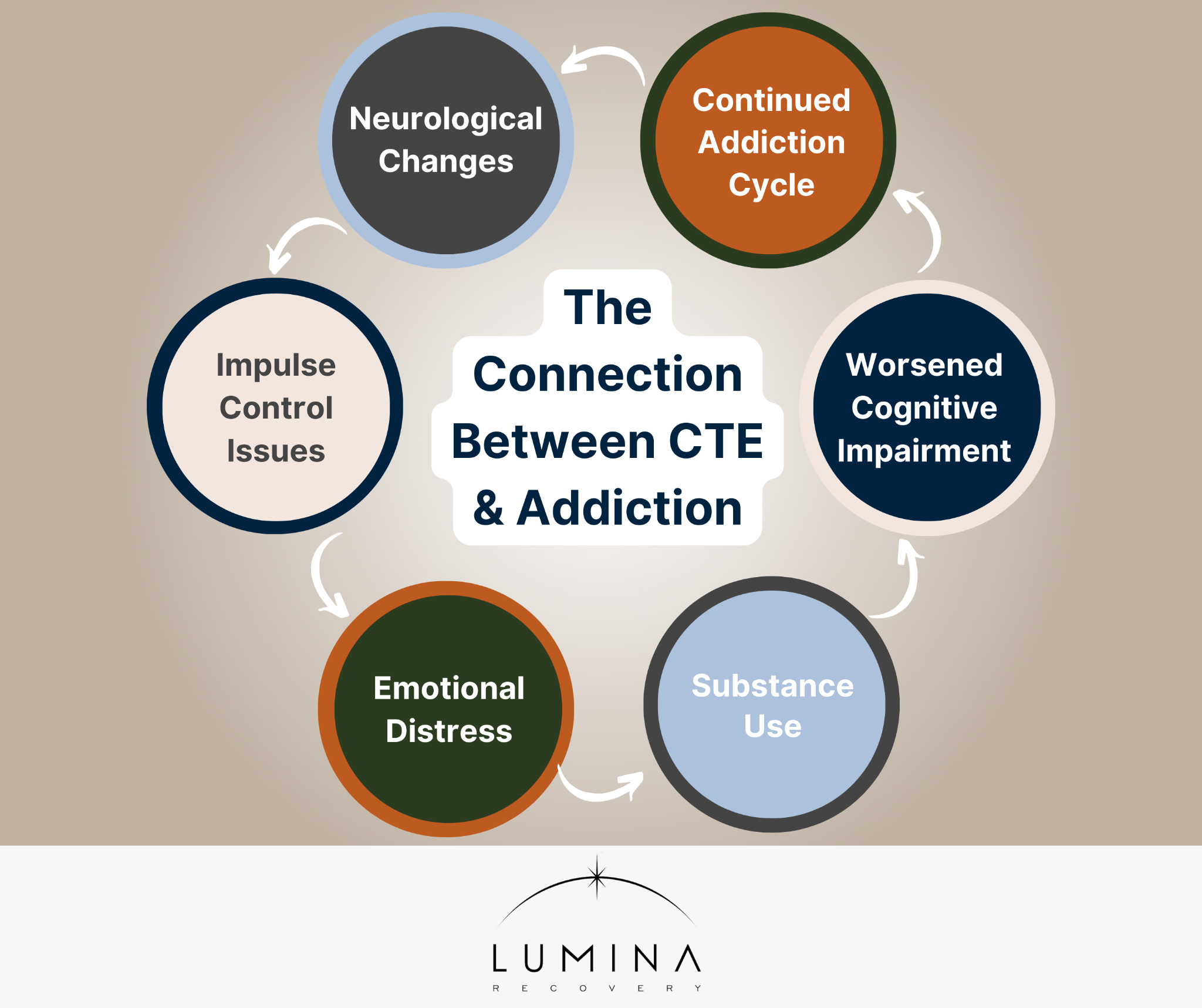Chronic traumatic encephalopathy (CTE) is a degenerative brain condition associated with repeated head injuries. Over the past decade, a concerning link between CTE and addiction has been detected, showing that individuals diagnosed with CTE are at a higher risk of substance abuse.
Understanding this connection is crucial, as it affects athletes, military personnel, and others with a history of traumatic brain injuries (TBIs).
What Is Chronic Traumatic Encephalopathy (CTE)?
CTE is a progressive neurodegenerative disorder linked to repeated head trauma. The chronic traumatic encephalopathy definition is a condition caused by repeated blows to the head, which result in the accumulation of tau protein in the brain. This protein buildup disrupts normal brain function and leads to significant neurological decline.1
CTE symptoms develop over time and worsen as the disease progresses. The early stages often involve mood swings, irritability, and mild cognitive issues. As the condition advances, individuals may experience memory loss, impulsivity, aggression, depression, and, in severe cases, dementia.1
The Science Behind Brain Trauma and Addiction
Repeated head trauma can cause long-term changes in brain structure and chemistry. Damage to the frontal lobe affects impulse control and decision-making, while disruptions in the dopamine system increase the risk of addiction.
Individuals with CTE may self-medicate with drugs or alcohol to manage emotional and cognitive difficulties caused by brain damage. These neurological changes can also contribute to shifts in mood regulation and stress response, further complicating recovery efforts.

The Connection Between CTE and Addiction
Individuals with CTE often face an increased risk of addiction due to the lasting effects of brain trauma on decision-making, impulse control, and emotional regulation.
- Neurological changes caused by repeated brain trauma disrupt normal brain function, making it harder to regulate emotions and decision-making.
- Weakened impulse control arises as damage to the frontal lobe reduces the ability to resist risky behaviors.
- Emotional distress such as anxiety, depression, and mood instability often follow, leading individuals to seek relief.
- Substance use becomes a coping mechanism for managing these difficulties, with individuals turning to alcohol, opioids, stimulants, or other substances.
- Worsened cognitive impairment results from prolonged substance abuse, further damaging brain function and making it even harder to quit.
- Continued addiction cycle develops as the combined effects of brain trauma and substance dependence reinforce destructive patterns, making recovery more challenging.
CTE and Alcohol
The relationship between alcohol and CTE is particularly alarming, as individuals may turn to alcohol as a coping mechanism. The combination of CTE and alcohol abuse can worsen cognitive and emotional symptoms, leading to a vicious cycle of addiction.
CTE and Methamphetamine
Studies have shown a growing association between chronic traumatic encephalopathy and methamphetamine addiction, suggesting that long-term methamphetamine use before a brain injury may intensify the damage and worsen TBI outcomes.2
Likewise, individuals with a history of TBI may be more susceptible to methamphetamine misuse and its harmful effects, further compounding cognitive and neurological impairments.
Statistical Overview of CTE and Addiction
Understanding the connection between CTE and addiction requires a look at the numbers.
Prevalence of CTE in Athletes and Military Personnel
- 4% of examined brains showed neuropathological findings of CTE3
- 87% of brains of former American football players in a study were diagnosed with CTE3
- 40% of contact sport athletes who died before age 30 were found to have CTE4
Correlation Between CTE and Substance Abuse
- 6% of individuals with CTE had a documented history of substance abuse before or alongside symptomatic CTE presentation5
- 10-20% of people with TBI develop new-onset SUD after injury6

Prevention, Early Intervention, and Treatment Options
Early recognition of CTE and its connection to addiction is crucial in preventing severe health consequences. Understanding the risks and taking proactive measures can significantly reduce the likelihood of substance abuse among individuals with a history of brain trauma.
Prevention
- Protective Gear reduces the risk of head trauma in contact sports and high-impact activities.
- Concussion Protocols ensure early detection and proper recovery time after head injuries.
Treatment and Rehabilitation
- Medication-assisted treatment (MAT) helps manage withdrawal symptoms and cravings for individuals struggling with addiction.
- Cognitive behavioral therapy (CBT) focuses on changing negative thought patterns and behaviors associated with substance use and CTE.
- Support groups provide a community for individuals experiencing similar struggles, offering shared experiences and coping strategies.
4 Steps for Affected Individuals and Families
Taking proactive steps can make a significant difference for individuals and families affected by CTE and addiction. Here are some key actions to consider:
- Seek professional help. Early intervention is crucial for managing CTE-related addiction.
- Educate yourself. Understanding the risks and symptoms can lead to better prevention.
- Explore treatment options. Look for specialized rehabilitation programs that address both CTE and substance abuse.
- Join a support network. Support groups are available for individuals dealing with CTE and their loved ones, as well as addiction recovery groups that offer valuable guidance.
FAQs
What is chronic traumatic encephalopathy (CTE)?
CTE is a progressive brain condition caused by repeated head injuries, commonly found in contact sport athletes and military personnel.
What are the symptoms of CTE?
Symptoms include memory loss, confusion, impaired judgment, aggression, depression, and, in advanced cases, dementia.
How is CTE diagnosed?
Currently, CTE can only be definitively diagnosed postmortem through brain tissue analysis. Researchers are testing brain imaging and diagnostic biomarkers for living individuals.1
Is there a link between CTE and addiction?
It has been found that there is a significant prevalence of substance abuse among individuals diagnosed with CTE, suggesting a correlation between the two.
Can substance abuse cause CTE?
While substance abuse is common among those with CTE, it is not considered a causative factor for the disease.
Get Help for Addiction With Lumina Recovery
Chronic traumatic encephalopathy (CTE) is a serious condition with profound effects on mental health and addiction risk. A strong link exists between brain trauma and substance abuse, highlighting the importance of early intervention.
If you or a loved one are struggling with addiction, Lumina Recovery offers specialized dual diagnosis treatment and partial hospitalization programs (PHPs) to support long-term healing.
Reach out today to learn more about our personalized treatment plans and start the journey toward recovery.
Sources:
- Mayo Clinic. Chronic traumatic encephalopathy.
- El Hayek S, Allouch F, Razafsha M, et al. Traumatic brain injury and methamphetamine: A double-hit neurological insult. J Neurol Sci. 2020 Apr 15;411:116711. doi: 10.1016/j.jns.2020.116711.
- Priemer DS, Iacono D, Rhodes CH, et al. Chronic traumatic encephalopathy in the brains of military personnel. N Engl J Med. 2022 Jun 8;386(23):2169-2177. doi: 10.1056/NEJMoa2203199.
- NIH. Chronic traumatic encephalopathy in young athletes.
- Maroon JC, Winkelman R, Bost J, et al. Chronic traumatic encephalopathy in contact sports: a systematic review of all reported pathological cases. PLoS One. 2015 Feb 11;10(2):e0117338. doi: 10.1371/journal.pone.0117338.
- Adams RS, Corrigan JD, Dams-O’Connor K. Opioid use among individuals with traumatic brain injury: a perfect storm? J Neurotrauma. 2020 Jan 1;37(1):211-216. doi: 10.1089/neu.2019.6451.


